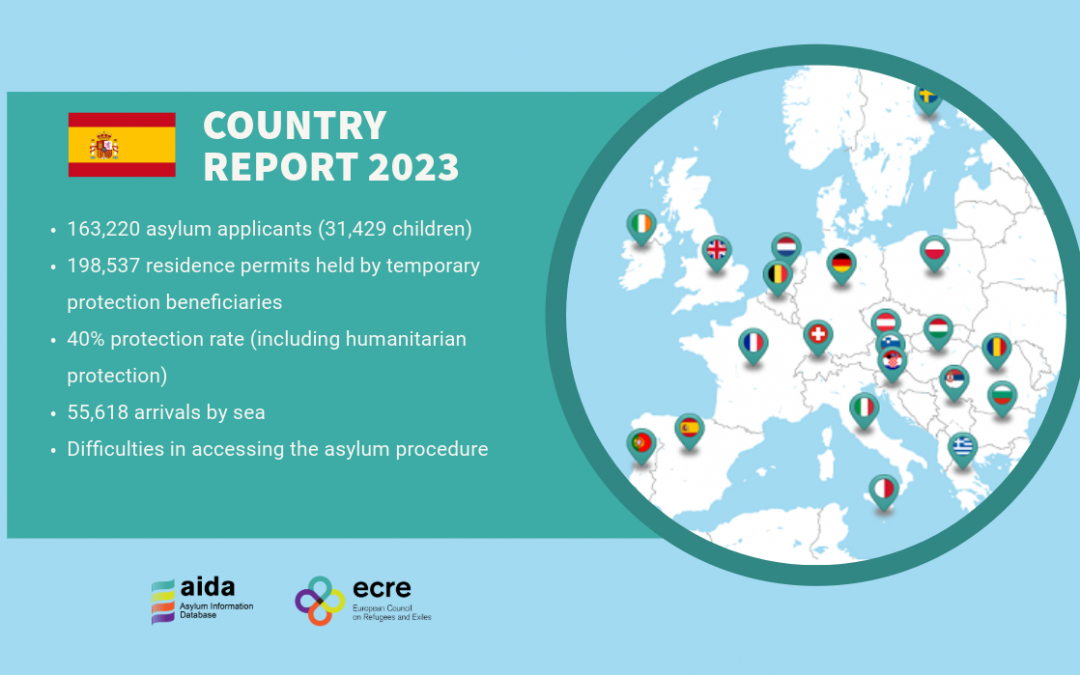The updated AIDA Country Report on Spain provides a detailed overview of legislative and practice-related developments in asylum procedures, reception conditions, detention of asylum seekers and content of international protection in 2023. It also includes an annex which provides an overview of temporary protection (TP).
A total of 163,220 people applied for international protection in Spain in 2023. 31,429 of them were children, both accompanied and unaccompanied. At the end of the year, 106,546 applications were still pending at first instance. The main countries of origin of asylum applicants were Venezuela, Colombia, Peru, Honduras and Cuba. 35,392 applications were rejected at first instance. Refugee status was granted to 7,330 people, subsidiary protection to 3,833 people and humanitarian protection to 41,487. The recognition rate for international protection remained low, with only around 17% of cases receiving a positive decision. However, the overall recognition rate was almost 40% when decisions granting humanitarian protection are included.
By the end of March 2024, a total of 198,537 residence permits were held by TP beneficiaries. By 31 December 2023, 37,011 students who had been displaced from Ukraine were able to access education and 20,593 TP beneficiaries (more than half of whom were women) were in employment.
56,852 irregular border crossings were registered in 2023. The vast majority of arrivals (55,618) were by sea with the main sea route being from Africa to the Canary Islands. 39,910 people arrived in the Canary Islands in 2023. The NGO Caminando Fronteras has estimated that 6,618 people died while trying to reach Spain in 2023 and that almost all of them (6,607) died along the Atlantic route.
Asylum seekers continued to face challenges in obtaining appointments to register their applications in 2023. Waiting times were as long as 12 months in certain provinces.
To improve the asylum reception system, the Government decided to allocate € 190 million in funding from the EU Recovery and Resilience Facility between 2021 and 2023. In 2022, it announced that it would open 17 new reception facilities. The construction of some of these centres started in 2023.
At the end of December 2023, there were reports of poor living conditions for asylum applicants in the border facility in Madrid-Barajas Airport. The Spanish Ombudsperson and the United Nations Refugee Agency (UNHCR) called on the Government to guarantee decent living conditions for asylum applicants at the airport. The Ministry of the Interior subsequently allocated more resources so that additional accommodation could be provided.
Regarding resettlement and safe pathways, in February 2023, the Spanish Council of Ministers approved the 2023 National Programme for Resettlement, which foresaw the resettlement of up to 1,200 people, and 92% of the pledges were implemented by the end of the year. At the beginning of March 2023, 89 Syrian refugees who had been affect by the earthquake in Türkiye were resettled. 72 Nicaraguans reached Spain from Costa Rica under a labour mobility pilot project linked to the country’s participation in the Safe Mobility Offices Initiative. In February 2024, the Government announced that the programme would be enlarged with a view to including 1,500 refugees from Central and South America in 2024 and 2025.
The full report is available here and the annex on temporary protection is available here.
For more information about the AIDA database or to read other AIDA reports, please visit the AIDA website.

